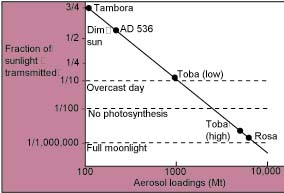
Left: Mt. Pinatubo eruption plume, July 1991, from Clark Air Base control tower. Photo by J.N. Marso, U.S. Geological Survey.
The effects of several historic eruptions have been observed and the impacts of larger, prehistoric eruptions can be estimated.

Estimates of the fraction of sunlight transmitted through stratigraphic aerosols after major eruptions. Roza refers to a flood basalt eruption in the northwestern United States. Graph from Rampino and others (1988).
The pages in this section explore the following case studies for their impact on global climate
| Toba, 75,000 years ago |
| Laki, Iceland, 1783 |
| Tambora, Indonesia, 1815 |
| Krakatau, 1886 |
| El Chichon, Mexico, 1982 |
| Mt. Pinatubo, Philippines, 1991 |
|
Eruption |
VEI (Explosivity Index) |
Magma Volume (km3) |
Column height (km) |
H2SO4 aerosols (kg) |
Northern Hemisphere temperature decrease |
|
Laki, 1783 |
4 |
14-15 |
<1 x10 11 |
about 1.0 |
|
|
Tambora, 1815 |
7 |
>50 |
>40 |
2x10 11 |
0.4-0.7 |
|
Krakatau, 1883 |
6 |
>10 |
>40 |
5x10 10 |
0.3 |
|
Santa Maria, 1902 |
6 |
about 9 |
>30 |
<2x10 10 |
0.4 |
|
Katmai, 1912 |
6 |
15 |
>27 |
<2x10 10 |
0.2 |
|
St.Helens, 1980 |
5 |
0.35 |
22 |
3x10 8 |
0-0.1 |
|
Agung, 1963 |
4 |
0.3-0.6 |
18 |
1-2x10 10 |
0.3 |
|
El Chichon, 1982 |
4 |
0.3-0.35 |
26 |
1-2x10 10 |
0.4-0.6 |
Data from Rampino and Self, 1984.